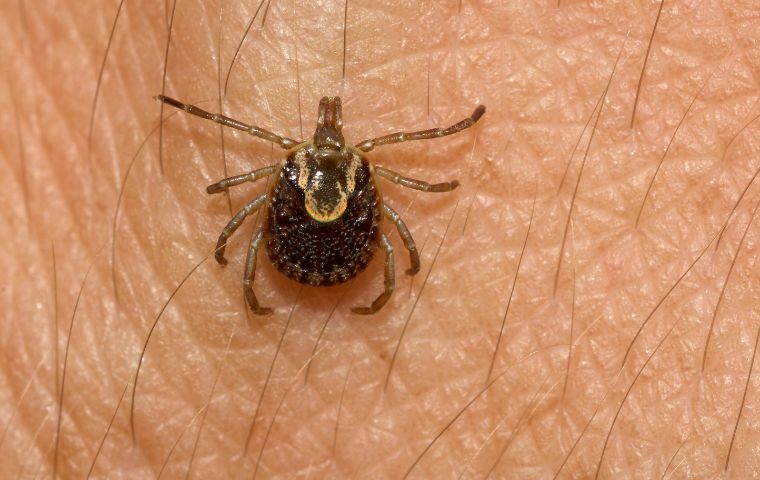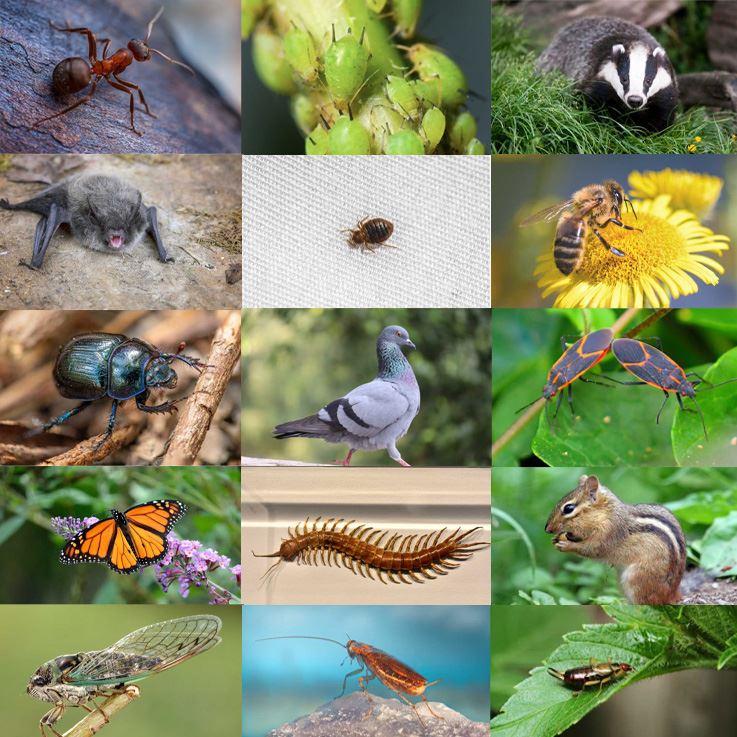
Gulf Coast Ticks
What Are Gulf Coast Ticks?
Gulf Coast ticks (Amblyomma maculatum) are a species of tick commonly found in the southeastern United States, particularly along the Gulf Coast region, but their range has been expanding in recent years. These ticks are known for their distinct appearance and are often recognized by their mottled or "spotted" appearance, which is where they get their name. The Gulf Coast tick is an important vector for several pathogens, making them a concern for both human and animal health.
Are Gulf Coast Ticks Harmful?
Gulf Coast ticks are notable vectors of several diseases and conditions, such as:
- Rocky Mountain Spotted Fever (RMSF): This is one of the most significant diseases spread by Gulf Coast ticks, caused by the bacterium Rickettsia rickettsii.
- Tick Paralysis: In some cases, the toxins from the Gulf Coast tick can cause paralysis in animals and humans. The paralysis is often temporary and reversible once the tick is removed.
- Other Potential Pathogens: Although less common, Gulf Coast ticks can also potentially transmit other pathogens, including Ehrlichia and Tularemia.
Additionally, these ticks can transmit a bacterium called Coxiella burnetii, which is responsible for Q fever, although this transmission is less well-documented compared to other tick species.
Gulf Coast Tick Appearance
Gulf Coast ticks (Amblyomma maculatum) are a type of tick commonly found in the southeastern United States, particularly in areas near the Gulf Coast. Here’s what they generally look like:
- Adult females are about 3 to 5 millimeters long before feeding and can swell up to 1 cm when engorged.
- Adult males are smaller, typically around 3 to 4 millimeters.
- Larvae are very small (less than 1 mm) and six-legged, typical of tick larvae.
- Nymphs have eight legs and appear somewhat similar to the adults but are smaller in size.
- Color: Their color can range from brown to reddish-brown.
- They have an oval shape, with a hard shield-like area called the scutum on their backs.
- Scutum: This dark-colored, shield-like structure covers part of their back, and it helps to distinguish them from other ticks.
- Distinctive Markings: Gulf Coast ticks have distinctive white or light-colored spots on the sides of their body, particularly on the scutum (the hard shield). These spots are one of their defining characteristics.
- Mouthparts: They have long, curved mouthparts (capitulum), which are visible from above, extending forward from the body.
They are often seen climbing vegetation or other surfaces, waiting to latch onto passing animals or humans. They are aggressive feeders, and they can attach firmly once they find a host.
Gulf Coast Tick Habitat
Gulf Coast ticks (Amblyomma maculatum) are most commonly found in specific geographic regions and environments. Here’s where you are most likely to encounter them:
Geographic Range:
Gulf Coast ticks are most prevalent in states along the Gulf of Mexico. These include:
- Texas
- Louisiana
- Mississippi
- Alabama
- Florida
- Georgia
They can also be found further inland, especially in parts of Tennessee, North Carolina, and Arkansas.
Habitat:
- Wooded Areas: These ticks are often found in wooded areas, particularly near the edges of forests, where there is plenty of vegetation.
- Grasslands: Tall grasses, particularly those near wooded areas or along roadways, are ideal habitats for Gulf Coast ticks, as they tend to climb onto grasses and shrubs to wait for a host.
- Scrublands and Fields: They are also common in open fields, prairies, and scrublands, especially those near areas where wildlife or livestock are present.
- Coastal Areas: As the name suggests, they are commonly found in regions close to the Gulf Coast, especially in areas with dense vegetation like marshes or wetland areas.
Associated Environments:
- Livestock Farms: Gulf Coast ticks often infest areas where livestock such as cattle, sheep, and horses are present. They are known to be more prevalent in these environments, as livestock provide an abundant host for ticks.
- Wildlife Habitats: These ticks are also found in areas frequented by wildlife, such as deer, raccoons, and other mammals that can carry them. Wildlife corridors and trails are common spots for tick encounters.
- Urban and Suburban Areas: While not as common, Gulf Coast ticks can occasionally be found in urban or suburban areas, particularly in parks, golf courses, or yards with tall grass and nearby wooded patches.
Gulf Coast Tick Diet
Gulf Coast ticks (Amblyomma maculatum) are hematophagous, meaning they feed on blood. They are ectoparasites, meaning they live on the outside of their host while feeding. The primary goal of their feeding is to obtain nutrients for growth and reproduction.
Hosts:
Gulf Coast ticks feed on the blood of a wide variety of animals, including:
- Mammals: These ticks are known to feed on both wildlife and domesticated animals. Common hosts include:
- Deer (white-tailed deer are a common host)
- Livestock (such as cattle, horses, and sheep)
- Raccoons, opossums, squirrels, and other small to medium-sized mammals
- Dogs and cats (pets that roam outdoors)
- Birds: They can also attach to and feed on various species of birds, especially migratory birds, which may transport ticks to new areas.
- Humans: Though not their primary hosts, Gulf Coast ticks can also latch onto humans if they happen to pass through tick-infested areas. This makes humans susceptible to tick-borne diseases.
Feeding Behavior:
- Questing: Gulf Coast ticks are ambush feeders, meaning they don’t actively hunt for a host. Instead, they wait in vegetation (such as grass, shrubs, or tree branches) for a host to pass by. This behavior is called "questing." They use their sensory structures (such as specialized mouthparts and antennae) to detect the carbon dioxide, body heat, and other chemicals released by potential hosts.
- Attachment and Feeding: Once a Gulf Coast tick attaches to a host, it inserts its mouthparts into the skin and begins feeding. The feeding process can last several days, as the tick becomes engorged with blood.
- Engorgement: A Gulf Coast tick can become significantly larger when it is engorged with blood. Female ticks, in particular, grow larger as they feed, as they need a substantial amount of blood to produce eggs.
While feeding, Gulf Coast ticks consume blood, which provides the protein, iron, and other nutrients necessary for their survival and reproduction. The feeding process involves the tick's saliva, which contains compounds that help it attach securely to the host's skin and prevent the host from feeling pain or noticing the tick. These compounds also have anticoagulant properties, which ensure that the blood flows smoothly while the tick feeds.

Gulf Coast Tick Life Cycle
The life cycle of the Gulf Coast tick (Amblyomma maculatum) follows a three-host tick pattern, which means that each developmental stage (larva, nymph, and adult) feeds on a different host. This species, known for transmitting Rickettsia parkeri (a cause of spotted fever rickettsiosis), has a complex life cycle influenced by environmental conditions, host availability, and seasonal factors.
Egg Stage
- Oviposition: After a blood meal, the engorged adult female drops off the host and lays several thousand eggs in the environment, typically in vegetation or soil with adequate humidity.
- Incubation: The eggs hatch in 2 to 4 weeks, depending on temperature and moisture levels.
Larval Stage (Seed Ticks)
- Host Seeking: After hatching, larvae (with six legs) actively seek a host, often small mammals or birds.
- Feeding: They attach to a host and feed for 3 to 7 days.
- Molting: After engorgement, larvae drop off the host and molt into nymphs over a period of 1 to 3 weeks, influenced by environmental conditions.
Nymphal Stage
- Host Seeking: Nymphs (now with eight legs) seek out a second host, which may be similar to or slightly larger than the larval host.
- Feeding: They attach and feed for 4 to 10 days.
- Molting: After feeding, nymphs drop off and molt into adults within 2 to 4 weeks.
Adult Stage
- Host Preference: Adult Gulf Coast ticks prefer larger hosts such as livestock (especially cattle), deer, dogs, and humans.
- Feeding: Adult males and females both feed, but only females become fully engorged.
- Mating: Mating typically occurs on the host.
- Reproduction: After mating and feeding, females drop off the host to lay eggs, restarting the cycle.
Total Life Cycle Duration
Under favorable conditions, the complete life cycle may be completed in several months, but in nature, it often takes up to one year or longer due to host availability and climate.
Key Environmental Influences
- Temperature & Humidity: High humidity and warm temperatures favor faster development and higher survival rates.
- Seasonality: Activity peaks in spring and summer, though adult ticks may persist into early fall in warmer regions.
Medical and Veterinary Significance
- Gulf Coast ticks are vectors of Rickettsia parkeri, which causes a form of spotted fever rickettsiosis in humans.
- Their bites can cause painful lesions, especially when they attach for extended periods.
- In animals, particularly cattle, their bites can lead to “gotch ear”, a condition where ticks attach to the base of the ear and cause deformation.
If you're trying to control Gulf Coast ticks, management strategies should target all life stages and focus on both environmental control (habitat reduction) and host-focused treatments (including wildlife exclusion and pet protection).

Hear From Our Happy Customers
-
"Fantastic & Patient"
Jarvis was fantastic and patient. He answered my questions with an in-depth explanation and addressed all of my areas of concern. Would love for him to be my assigned tech going forward. Well done!
- Yonnette M. -
"Exceeds Expectations"
I can’t say enough positive things about this company... The tech that came out, Jarvis went above and beyond my expectations. Thank you guys, I will continue using your services.
- Jake M. -
"Professional & Considerate"
I’m pleased with Miche services. Jarvis came today. Professional and considerate. Thank you!
- Judy B. -
"Great Communication"
Tech was on time, communication was great, and he accommodated my needs.
- Alonzo W. -
"Wonderful Service"
Wonderful service. Jarvis is great. Took care of everything I needed. Thank you!
- Henry P. -
"Very Knowledgeable"
The tech that arrived was courteous, professional, and very knowledgeable. He was Great.
- Uerial I.



